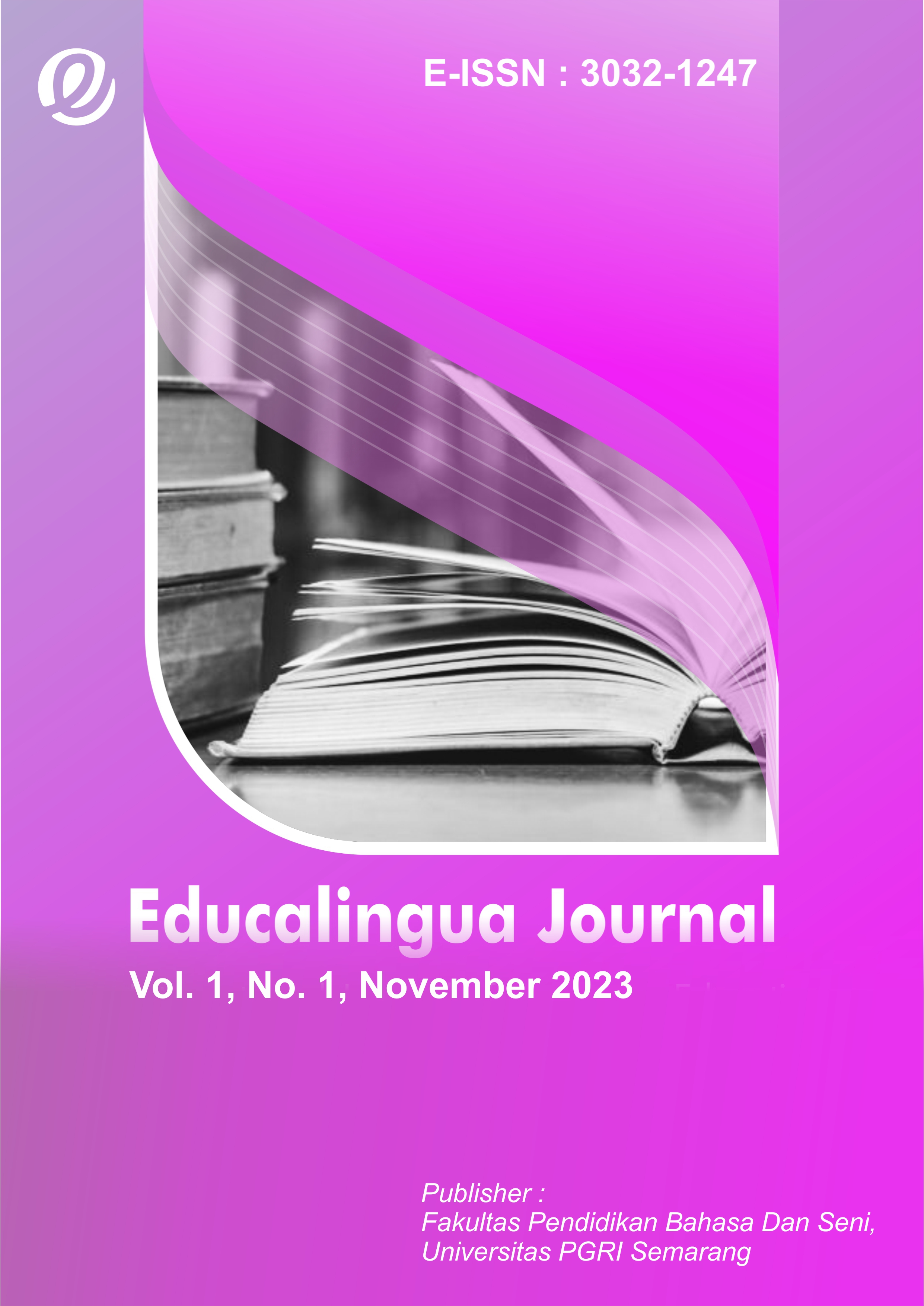Pause toward Nassie Judge’ Speech on Nassie Judge’ Youtube
DOI:
https://doi.org/10.26877/educalingua.v1i1.215Keywords:
pause, speech, Nessie JudgeAbstract
Pause is one of the speech impediments that anyone can experience. This study aims to determine the forms of pause and the reasons that cause pause in Nessie Judge's speech. The data used is in the form of Nessie Judge's utterances which contain pauses. The approach used in this research is descriptive qualitative. The methods used to collect data are documentation techniques, observation methods, and note-taking techniques. The data obtained were then analyzed using the matching and distribution method. Based on the data analysis carried out, the results are in the form of two forms of pause, namely silent pause and filled pause. The reasons that caused Nessie Judge to experience pause, namely forgetting, attracting attention, looking for the right words, giving time to understand the utterances, taking a breath, already starting the utterances, and being careful when speaking.
References
Anderson, G., Herr, K., & Nihlen, A. (2014). Studying Your Own School: An Educator’s Guide to Practitioner Action Research. Studying Your Own School: An Educator’s Guide to Practitioner Action Research, 26–28. https://doi.org/10.4135/9781483329574
Aspers, P., & Corte, U. (2021). What is Qualitative in Research. Qualitative Sociology, 44(4), 599–608. https://doi.org/10.1007/s11133-021-09497-w
Buckland, A. (2015). More Than Consumers. What Libraries Publish, 0, 193–202.
Cahya Ningtias, F., Fani Prastikawati, E., & Wahyuni, S. (2021). British Council Podcast Apps To Improve Students’ Listening Comprehension. Wiralodra English Journal (WEJ), 5(2), 28–38. https://doi.org/10.31943/wej.v5i2.134
Daryanto, A. P., Setyaji, A., & Prastikawati, E. F. (2022). Interpersonal Meaning Analysis of The Weeknd Song Lyrics in After Hours’ Album. International Journal of Research in Education, 2(2), 123–131. https://doi.org/10.26877/ijre.v2i2.11727
Handayani, E. N., Ismiyatin, L., & Setiyowati, D. (2019). Tindak Tutur Ekspresif Humanis dalam Interaksi Pembelajaran. Buletin Pengembangan Perangkat Pembelajaran, 1(1), 111–122. https://doi.org/10.23917/bppp.v1i1.9289
Izar, J., Nasution, M. M., Afria, R., Harianto, N., & Sholiha, M. (2021). Expressive Speech Act In Comic Bintang Emon’s Speech In Social Media About Social Distancing. Jurnal Ilmu Humaniora, 05(1), 148–158.
Kurniawati, W. (2018). Senyapan dalam Tuturan Berbahasa Indonesia: Studi terhadap Tuturan pada“Debat Pilkada DKI 2017.” Widyaparwa, 46(1), 75–90. https://doi.org/10.26499/wdprw.v46i1.165
Liando, N. V. F., & Tatipang, D. P. (2022). English or Indonesian Language? Parents’ Perception Toward Children’s Second Language Learning Context. Jurnal Lingua Idea, 13(1), 61. https://doi.org/10.20884/1.jli.2022.13.1.5749
Lumentut, Y., & Lengkoan, F. (2021). the Relationships of Psycholinguistics in Acquisition and Language Learning. Journal of English Culture, Language, Literature and Education, 9(1), 17–26. https://doi.org/10.53682/eclue.v9i1.1894
Maeskina, M. M., Hidayat, D., & Maharani, I. F. (2021). IPPAR Model Pendekatan Content creator Dalam Mempertahankan Reputasi Di Media Snack Video. Communicatus: Jurnal Ilmu Komunikasi, 5(2), 161–184. https://doi.org/10.15575/cjik.v5i2.14624
Mondada, L., & Doehler, S. P. (2005). Second language acquisition as situated practice: Task accomplishment in the french second language classroom. Canadian Modern Language Review, 61(4), 461–490. https://doi.org/10.3138/cmlr.61.4.461
Ni’mah, K. (2018). The implementation of reading corner and teacher modeling in Indonesian learning through psycholinguistic approach. MUDARRISA: Journal of Islamic Education, 10(1), 47. https://doi.org/10.18326/mdr.v10i1.47-72
Shelton, C. C., & Archambault, L. M. (2019). Who Are Online Teacherpreneurs and What Do They Do? A Survey of Content Creators on TeachersPayTeachers.com. Journal of Research on Technology in Education, 51(4), 398–414. https://doi.org/10.1080/15391523.2019.1666757
Sibarani, C. (2019). Students? Perceptions of Teachers? Use of Bahasa Indonesia in the English Classroom. JET (Journal of English Teaching), 5(3), 217. https://doi.org/10.33541/jet.v5i3.1315
Student, M. T., Kumar, R. R., Omments, R. E. C., Prajapati, A., Blockchain, T.-A., Ml, A. I., Randive, P. S. N., Chaudhari, S., Barde, S., Devices, E., Mittal, S., Schmidt, M. W. M., Id, S. N. A., PREISER, W. F. E., OSTROFF, E., Choudhary, R., Bit-cell, M., In, S. S., Fullfillment, P., … Fellowship, W. (2021). Prosedur penelitian suatu pendekatan praktik. Frontiers in Neuroscience, 14(1), 1–13.
Sukaton, O. (2018). ELS Journal on Interdisciplinary Studies on Humanities. 1(2), 218–225. https://doi.org/10.34050/els-jish.v2i1.6008
Susiati, Tenriawali, A. Y., & Taufik. (2020). Bahan Ajar Psikolingustik. 89. https://osf.io/9hveb
Tarigan, H. G. (2008). Berbicara Sebagai Suatu Keterampilan Berbahasa.
Van Klaveren, C., & De Wolf, I. (2019). Systematic Reviews in Education Research: In Contemporary Economic Perspectives in Education. https://doi.org/10.2307/j.ctt14jxsqg.4
Vindrola-Padros, C., & Johnson, G. A. (2016). Rapid techniques in qualitative research: a critical review of the literature. Qualitative health research, 30(10), 1596-1604.
Widarti, H. R., Anggraini, T., Rokhim, D. A., & Syafruddin, A. B. (2022). Learning Innovation Content Creators Social Media-Based Qualitative Analysis to Improve Motivation and Learning Outcomes of Professional Teacher Candidates: A Systematic Literature Review. Orbital, 14(4), 267–275. https://doi.org/10.17807/orbital.v14i4.16254





